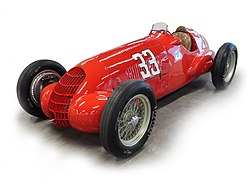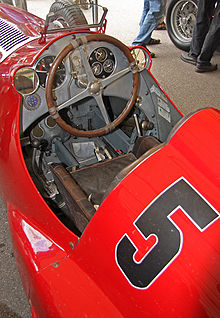Alfa Romeo Tipo 308
| Constructor: | Gioachino Colombo | ||||||||
| Predecessor: | Alfa Romeo 12C | ||||||||
| Successor: | Alfa Romeo 158 | ||||||||
| Technical specifications | |||||||||
|---|---|---|---|---|---|---|---|---|---|
| Chassis: | conventional lead frame | ||||||||
| Engine: | 8-cylinder in-line engine with 2991 cm³ |
||||||||
| Length: | 4000 mm | ||||||||
| Height: | 1160 mm | ||||||||
| Wheelbase: | 2750 mm | ||||||||
| Weight: | 870 kg | ||||||||
| Tires: | Pirelli | ||||||||
| Petrol: | petrol | ||||||||
| statistics | |||||||||
| Driver: |
|
||||||||
|
|||||||||
| World Cup points: | - | ||||||||
| Podiums: | - | ||||||||
| Leadership laps: | k. A. / tba | ||||||||
The Alfa Romeo Tipo 308 (or 8C-308) was a racing car that Alfa Romeo produced in 4 copies in 1938. It was designed by Gioachino Colombo under the direction of Enzo Ferrari , at that time still director of the racing department "Alfa Corse" . The vehicle had already been adapted to the new international regulations for Grand Prix vehicles, which from 1938 stipulated a maximum displacement of 3000 cm³ for turbocharged engines and 4500 cm³ for conventional naturally aspirated engines.
backgrounds
In the 1938 season there were some dramatic changes at Alfa Romeo: After the works cars had previously been racing under the direction of Scuderia Ferrari , the company had decided to compete again as a full works team under its own name. Scuderia Ferrari, in which Alfa Romeo had held the majority of the company shares since the previous year, was dissolved, Enzo Ferrari retained his position as race director and manager of the team for a year before he finally left the company at the end of 1938.
Due to the change in the racing formula, a new design was necessary. Since the development of the V12 engine that was actually intended for this purpose was delayed, a version of the tried and tested eight-cylinder in-line from the Tipo B was again used as an interim solution, as was the case with the predecessor, the Alfa Romeo Tipo C.
development
The project made extensive use of elements from the Alfa Romeo Tipo C , but also adopted elements from the 8C 2900 B two-seater sports car . The engine was built deeper into the Tipo-C chassis and the body was slimmer. Compared to the 8C 2900 B, the wheelbase has been shortened to 2750 mm and the driver's position has been moved to the center by changing the pedal and steering elements to adapt it to the monoposto position. Incidentally, the car followed the tried and tested components of the 8C 2900 B with independent wheel suspension, a four-speed gearbox installed at the rear and hydraulically operated drum brakes. The light metal body anticipated the shape of the Tipo 158 "Alfetta" , which Enzo Ferrari's team had developed.
Vehicles with 12 and 16-cylinder engines were prepared for the later seasons, also with the Tipo-C chassis. With their 295 hp, the four 308C were not serious candidates for Grand Prix victories against the German competitors who had over 425 hp. Nuvolari suffered a carburetor fire on the debut of the 308C and then left the team.
Racing history
The Tipo 308 debuted in 1938 at the Grand Prix de Pau , where two cars appeared, one with Tazio Nuvolari and the other with Luigi Villoresi at the wheel. Nuvolari initially set satisfactory times in practice, but then his car caught fire from a gas leak and both cars were withdrawn from the race. Nuvolari, who suffered burns to his legs, left the team for good and declared that he would never compete for Alfa Romeo again.
The next race was the Tripoli Grand Prix . The new Tipo 312 (3 liters, 12 cylinders) and Tipo 316 (3 liters, 16 cylinders) were supposed to be used here, but had engine problems during the training and Clemente Biondetti decided on the 308, which was intended as a replacement car. He couldn't finish the race; Hermann Lang, who drove a Mercedes-Benz W 154 , won. Eugenio Siena , who started on a Tipo 312, had a fatal accident; he had lost the track and hit a wall.
At the Mille Miglia 1938 , Biondetti and Carlo Pintacuda took the first two places. Biondetti's car had a Tipo 308 engine with 300 hp (220 kW), while Pintacuda drove a 2900 B with 225 hp (168 kW).
In 1938 and 1939 the Frenchman Raymond Sommer won several hill climbs in La Turbie with the 308 . His compatriot Jean-Pierre Wimille was successful in several races in Europe in the 1940s. One of the cars was brought to Argentina, where it achieved some successes and victories with Óscar Alfredo Gálvez at the wheel. The car that Gálvez used in Argentina is now in the Juan Manuel Fangio Museum.
One of the vehicles was sold to the United States after World War II, and Louis Durant took 6th place in the Indianapolis 500 in 1946 . The next year the car finished 7th with Walt Brown , and in 1948 Johnny Mauro drove the car to 8th place. This car is now in the Indianapolis Motor Speedway Hall of Fame Museum. It is very likely the same car that was used on the Indianapolis 500 in 1940 and was previously driven by Raymond Sommer.
Overall, the 3-liter formula cars from Alfa Romeo (Tipo 308, 312 and 316) were not a great success. The new car for the 1500 cm³ class, the Tipo 158 "Alfetta" , designed in 1937 and which competed for the first time at the Coppa Ciano in Livorno in August 1938, proved to be much more successful .
statistics
Important victories
Indianapolis 500 results
| year | driver | placement |
|---|---|---|
| 1940 |
|
17th |
| 1946 |
|
6th |
| 1947 |
|
7th |
| 1948 |
|
8th. |
Technical information
| Alfa Romeo Tipo 308 | |
|---|---|
| engine | 8-cylinder in-line engine |
| Displacement | 2991 cc / 182.5 cu in |
| Bore × stroke | 69.0 mm × 100.0 mm |
| Compression ratio | 6.1: 1 |
| Power at 1 / min | 295 PS / 220 kW at 6000 rpm |
| Valve control | two overhead camshafts / 2 valves per cylinder |
| Mixture preparation | 2 Weber carburettors , double Roots blowers |
| cooling | water |
| transmission | 4-speed gearbox, not synchronized (rear-wheel drive) |
| Brakes | hydraulically operated drum brakes on all wheels |
| Front suspension | Cross arms, coil springs, hydraulic dampers |
| Rear suspension | Pendulum axle , semi-elliptical transverse leaf springs, hydraulic telescopic dampers, friction dampers |
| Body and frame | Aluminum body on a ladder frame |
| wheelbase | 2750 mm |
| Track width front / rear | 1350 mm / 1350 mm |
| Front tire size | unknown |
| Rear tire size | unknown |
| Dimensions L × W × H | 4000 mm × - × 1160 mm |
| Empty weight (without driver) | 870 kg |
| Tank capacity | unknown |
| Fuel consumption | unknown |
| Top speed | 260 km / h (162 mph) |
Whereabouts
Two of the four built 308C are still preserved. The first example, like so many other racing cars, was sold to South America after the war. There it was rediscovered in the 1970s, brought back to Europe and restored. Today it is fully functional and has a 3.2 liter engine. For example, it was seen at the Goodwood Revival meeting in 2006. The second car was sold to the United States in 1940. Driven by Louis Durant, the car finished sixth in the 1946 Indy 500, a year later Walt Brown finished seventh and on the last appearance of the car, Johnny Mauro finished eighth. It was in service in the United States until 1951 and is now part of the Indianapolis Motor Speedway Museum.
Web links
- Ultimatecarpage.com Information on Type 308.Retrieved June 6, 2020 (English)
- Goodwood.com “Wild on-edge hillclimb from 80-year-old Alfa Romeo”. Accessed June 6, 2020
- Goodwood.com "Wild 80-year-old Alfa Romeo slices through the pack". Accessed June 6, 2020
Individual evidence
- ↑ 1938 Alfa Romeo 308C - Images, Specifications and Information. Retrieved June 6, 2020 .
- ↑ The Golden Era - 1938 Season Lineup. Accessed June 7, 2020 (English).
- ↑ Borgeson, Griffith. The Alfa Romeo Tradition . ISBN ISBN 0-85429-875-4 .
- ↑ Venables, David. First among champions . ISBN ISBN 1-85960-631-8 .
- ^ A b The Unknown History of the 308 in Argentina. April 7, 2007, accessed June 6, 2020 .
- ↑ The Golden Era - 1938 Grand Prix de Pau. Accessed June 7, 2020 (English).
- ↑ Title: "Classic and Sportscar" magazine, Published: April 2007, Article: "Alfa 8C-2900B MM", p. 192, ISSN 0263-3183
- ↑ Un tributo al chueco ... Museo Juan Manuel Fangio - Alfa Romeo 8C-308. Retrieved June 6, 2020 (Spanish).
- ↑ Johnny Mauro. September 29, 2007, accessed June 6, 2020 .
- ↑ CARS (PART 1) ALFA ROMEO. April 19, 2007, accessed June 6, 2020 .
- ↑ 1938 Alfa Romeo 308C Specifications. Retrieved June 6, 2020 .
- ↑ 1938 Alfa Romeo 308C - Images, Specifications and Information. Retrieved June 6, 2020 .





